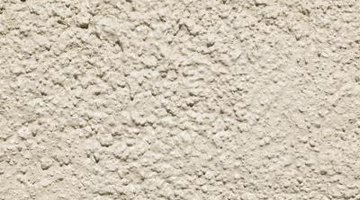Exterior Rough Finish Techniques
Refinishing your home's exterior with a rough finishing technique can bring new life to old, worn-looking masonry. Whether you want to improve the weather-resistance of your walls or give your house a facelift, you can rough-finish your walls on your own with a few supplies and basic techniques.
Preparing Your Wall

No matter how you choose to finish your exterior, you'll first need to get your wall in shape for finishing. If you walls are older and untreated, you'll need to power-wash them to remove any dirt, debris, mold or other contaminants. Previously painted walls might need to be sandblasted before they'll be ready to finish. If the walls have any cracks or holes, fill them first in with a synthetic water-resistant putty.
Sand Finish
Finishing your exterior walls with sand-textured paint puts you in control of just how much texture you have. While some brands of paint come pre-texturized with sand, mixing your own will save you money and give you more creative control. Choose a latex paint made for exterior use and experiment with a small amount of paint and silica sand until you get a texture you like. Apply two coats of the textured paint to your walls using a low pile or sponge roller.
Stucco Finish
Stucco, one of the oldest textured surfaces, helps insulate your home and is easy to apply. Mix the stucco, lime and sand in a large wheelbarrow according to the stucco manufacturer directions. Add water until the mixture reaches a thick frosting-like consistency. Gently mist your wall with a garden hose before applying a base coat of stucco to the wall with sweeping strokes of a trowel to form a three-eighths inch thick layer. Start at the bottom and work your way up the wall. Once the surface loses its sheen, work a foam or wooden mason's float over the entire surface in a swirling motion. Let the base coat dry overnight before mixing and applying a quarter- to an eighth-inch top coat of stucco. Tool the surface with a sponge float or brush until you have the desired texture.
Rendering
Rendering refers to the process of applying a mixture of cement, sand and lime plaster to the surface of an exterior wall in order to add a weather-resistant seal. After the wall has been rendered, you can paint it in the color of your choice. The process of rendering is similar to stuccoing. Mix the materials according to manufacturer directions and apply a base coat and a top coat, each less than 5 millimeters thick, to the dampened surface of the wall. Texture the top coat as desired.
References
Writer Bio
Lydia Stephens began writing professionally in 2009. She has written online for Nile Guides, SheKnows.com and various other websites and has been published in "Stringing Magazine" and "Xiamen Wave." Stephens played competitive soccer for 19 years, has been weight lifting since 2007 and enjoys running, biking and sailing. She has a Bachelor of Arts in philosophy from the University of Texas.
Photo Credits
- Hemera Technologies/AbleStock.com/Getty Images
More Articles



